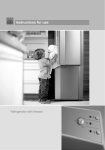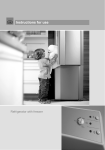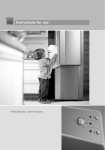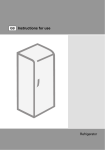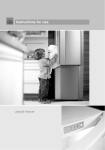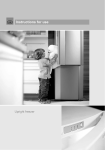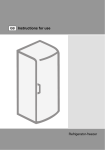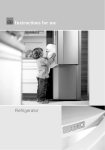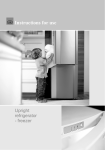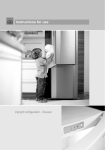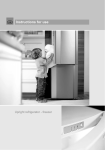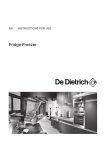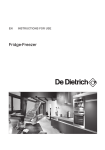Download Smeg CR325APZD fridge-freezer
Transcript
GB Instructions for use Upright refrigerator-freezer Upright refrigerator-freezer Thank you for your confidence in buying our appliance and congratulations on the excellent choice. We hope it will successfully serve its purpose for many years. Upright refrigerator - freezer (hereinafter: the appliance) consists of two parts: top part is refrigerator and bottom part is upright freezer. Refrigerator is used in households for storage of fresh food at temperatures above 0°C. Freezer is used in households for freezing fresh food and storage of frozen food for up to one year (depending on the type of food). 181300 Before first operation .................................................. 3 Description of the appliance ...................................... 5 Installation and connections ...................................... 6 Changing the Direction of Opening the Door ........... 8 Control panel - appliance with electronical regulation ..................................................................... 9 Control panel - Appliance with mechanical regulation .................................................................. 14 Refrigerator accessories .......................................... 14 Storage of food in the refrigerator ........................... 16 Storage of food in the FRESH ZONE ....................... 17 Freezing and storage of frozen food ....................... 18 Defrosting the appliance........................................... 20 Cleaning the appliance ............................................. 21 Troubleshooting guide .............................................. 22 Noise level .................................................................. 23 2 Before first operation 181300 • The appliance is manufactured in compliance with all relevant safety standards; however, it is recommended that persons with impaired physical, motional, or mental abilities, or persons with inadequate experience and knowledge, do not use the appliance without due supervision. The same recommendation applies to minors using the appliance. • Before connecting the appliance read these instructions carefully. They describe the appliance and provide instructions for its safe and correct use. The instructions are prepared for different types and models of the appliance so they may contain descriptions of functions and components your appliance may not have. • These instructions also contain the NO FROST version of the freezer, fitted with the fan and featuring automatic defrosting. • Remove the wrapping protecting the appliance during transport. • Wrappings contain environmentally friendly materials which can be recycled, recovered or disposed off without threat to the environment. • On the door corners (on freestanding appliances) or on the housing of the appliances (on built-in appliances) the spacers are installed, which should be removed and replaced with the attached spacer-plugs. • Before connecting the appliance to the mains supply, leave it in upright position for about 2 hours. This will reduce possibility of malfunctions in the cooling system resulting from prior transport and handling. • The appliance must be connected to the mains supply in accordance with the standing regulations and local requirements. • The appliance must not be used in open air or exposed to weather precipitation. • Always disconnect the appliance from power supply (pull the power cord from wall socket) before cleaning and before replacing the light bulb. • If the power supply cord is damaged, in order to avoid hazard it must be replaced by the service or by qualified personnel. • In case of longer disuse first turn the appliance off with the ON/OFF button and disconnect it from mains supply. Empty the appliance, clean the interior and leave the door ajar. • For the protection of environment deliver the obsolete appliance to the authorized scrap appliance dealers. • Never let the children play with the appliance. • Self closing shear door hinge pulls the door to the cabinet just before closing, thereby preventing the door to remain ajar. Equally it limits the door opening angle and prevents damage to adjacent elements. • Rating plate with basic information is located in the interior of the appliance. If the sticker plate is not suitable for your language, replace it with the attached one. • Warning: Ventilation slots on the appliance or built-in element should always be kept clean and unobstructed. • Warning: Do not use any mechanical accessories when thawing the refrigerator, except for those explicitly recommended by the manufacturer. • Warning: To prevent any pollution be careful not to damage the insulation or refrigeration tubes at the rear wall during the installation, cleaning and disposal of the appliance. • Warning: Do not use any electrical devices inside the appliance, except for those explicitly recommended by the manufacturer. 3 The symbol on the product or on its packaging indicates that this product may not be treated as household waste. Instead it shall be handed over to the applicable collection point for the recycling of electrical and electronic equipment. By ensuring this product is disposed of correctly, you will help prevent potential negative consequences for the environment and human health, which could otherwise be caused by inappropriate waste handling of thisproduct. For more detailed information about recycling of this product, please contact your local city office, your household waste disposal service or the shop where you purchased the product. 181300 4 Description of the appliance Interior equipment of the appliance will typically vary according to the specific model. A 1 2 3 4 5 6 7 8 Refrigerator Fan Interior light Control panel Horizontal bottle rack Adjustable glass shelves Pull-out glass shelf (adjustable height) Removable snack tray Foldable egg rack (closed - 6 eggs, open - 12 eggs) 9 FRESH ZONE pan 10 Vegetable crisp pan 11 Refrigerator door pans (options: deep, shallow; covered or no cover) 12 Door bottle rack with safety holder 181300 B Freezer 13 Storage compartment 14 Freezing compartment 15 Legs 5 Installation and connections Selecting the location Positioning the appliance • Place the appliance in dry and well aired room. The appliance operates best at temperature ranges indicated in the chart below. Relevant class of the appliance is indicated on the rating plate. Class Ambient temperature SN (subnormal) from + 10°C to + 32°C N (normal) from + 16°C to + 32°C ST (subtropical) from + 16°C to + 38°C T (tropical) from + 16°C to + 43°C Positioning the appliance requires two persons in order to avoid injuries or damage to the appliance. • Place the appliance flatly and firmly on a solid base. The appliance is fitted with adjustable feet on the front side, used to level the appliance (certain models only). • Avoid exposing the appliance to direct sunlight or heat sources. If this is not feasible, install insulation plate between the appliance and adjacent heat source. • The appliance may stand independently or you may incorporate it into the kitchen cabinet. Be sure to leave enough space for cooling of condenser (distance from the wall or the opening should be 200 cm2). Distance to the cabinet above the appliance should be at least 5 cm. After the installation, the appliance mains plug should be accessible! 181300 6 • The appliance is fitted with spacers to be mounted on the top edge of the condenser. They prevent the rear of the appliance to be pushed too close to the wall. Spacers are fabricated universally regarding the different distance of the condenser from the cabinet, so make sure to position them properly. • Use the power cord to connect the appliance to the mains power. Wall outlet must be fitted with ground terminal (safety socket). Required nominal voltage and frequency are indicated on the relevant label or rating plate of the appliance. • Mains power connection and grounding must be made in line with standing regulations and local requirements. The appliance is able to accommodate minor temporary voltage tolerances, but they may not exceed -6% to +6%. 181300 Connecting to power supply 7 Changing the Direction of Opening the Door Freestanding appliance Necessary tools: ring spanner No.8, screwdriver, torque 25 Tilt the appliance so that the bottom hinge can be unscrewed and proceed with disassembling as shown in the Figure 3. Then fix the assembly parts again in the opposite turn. Use the attached opposite hinge insert piece. Use the bungs, which have been pulled out, on the opposite side. Check the door seal. In case that it does not rest well, take it off and turn it by 180°. 181300 8 Control panel - appliance with electronical regulation CONTROL UNIT I CONTROL UNIT II No frost system appliance A Digital temperature display (certain models only) of the refrigerator indicates actual temperatures during the operation from +1°C to +9°C. B ON/OFF and temperature setting button C Orange LED: illuminated during fan operation (knob D). D Fast cooling fan activation knob The appliance is switched on by turning the button (B) towards Max, and accordingly switched off when the arrow (small (the triangle) on the button points to the ON/OFF mark appliance, however, is still under mains power). 181300 ON/OFF button 9 Refrigerator temperature setting • • • • • (control panel I) Start of fan assisted cooling Temperature of the appliance is set by turning the button (B) to the position between the Min and Max span. Recommended setting of the thermostat knob is to ECO position. If the room temperature, in which the appliance is installed, is lower than 16°C, the recommended setting of the thermostat knob is to the Max. In case of exceptionally higher ambient temperatures it is recommended to switch the fan operation at high speed by pressing button (D) – only for models featuring control panel I. SF/SC position - SF position stands for “Super frost” and indicates fast freezing (certain models only). - SC position stands for “Super cool” and indicates fast cooling (certain models only). • In apliances with digital display the indicator flashes during the setting procedure, and the beep signals each change of preset temperature. When flashing stops the final setting is stored in memory. • When the appliance is switched on, the display (A) will flash for a few seconds – the set value will be indicated. After a while, the actual or maximum value is indicated. This value will remain on the display until the actual temperature in the refrigerator compartment falls below the displayed level. Fan assisted fast cooling is started by pressing the button (D). Orange LED is on. Fan eliminates minor temperature differences between different cabinet spaces, and reduces dew formation on the interior surface of the appliance. The fan operates only at closed refrigerator door. (control panel I) Fast freezing function 181300 10 Fast freezing function is activated by turning the button (B) arrow (triangle) to the position SF/SC. If the function is not switched off manually it stops automatically (after approximately two days of operation). • After the automatic stop of the fast freeze function the appliance switches to regular operation mode at Max. setting, so you need to turn the button (B) back to your preferred setting. • The fast freeze function is used after the first start of the appliance, before major cleaning, or when large quantity of fresh food is stored in the freezer. • To repeat the fast freeze function you need to first turn the knob (B) from the SF/SC position to the position Eco, and then back to the position SF/SC! Open refrigerator door alarm (control panel I) The alarm sounds if the refrigerator door is left open for more than 1 minute. When the door is closed again the alarm stops. CONTROL UNIT III Valve and no frost system appliance A Freezer temperature setting button B Freezer temperature digital display: indicates temperature span between -16°C and -24°C. C Fast freeze button ON/OFF D Orange LED: indicates fast freeze setting in operation E Mains ON/OFF button (both refrigerator and freezer) F Green LED: indicates freezer operation G Alarm off button and child lock ON/OFF button Red LED: indicates alarm state Refrigerator ON/OFF button Green LED: indicates refrigerator operation Fast refrigerator cooling ON/OFF button Orange LED: indicates fast refrigerator cooling setting in operation M Digital refrigerator temperature display: indicates temperature span between +1°C and +9°C. N Refrigerator temperature setting button First plug the power cord into the wall outlet. The LCD display is on and indicates dashes. This means that both the refrigerator and the freezer are off. • Switch the appliance on/off by pressing button (E) for 3 seconds. Both the refrigerator and the freezer are on, green LED’s (F) and (J) are on. In this mode you can switch only the refrigerator off by pressing the button (I) for 3 seconds (green LED (J) is off). • Display indicates refrigerator temperature +9°C and freezer temperature 0°C. These values remain on the display until the actual temperature within the cabinet units falls below the above values. • The appliance is factory preset to the recommendable refrigerator temperature of +5°C and freezer temperature of 18 °C. 11 181300 Mains ON/OFF button H I J K L Temperature setting • • • • Other settings Refrigerator temperature setting span +1°C do +9°C Freezer temperature setting span -16°C to -24°C + fast freeze Freezer temperature is set by the button (A), and refrigerator temperature by the button (N). When you press one of temperature setting buttons, the digital display starts flashing and indicates the last selected temperature. Temperature setting is changed by short sequence pressing of the button in steps of 1°C. During the setting procedure all other buttons are void. Around 5 seconds after the release of the button, the display automatically indicates the actual temperature in the refrigerator and in the freezer. Continuous sound - opened refrigerator door - alarm If the refrigerator door is open for more than one minute, the sound signal (continuous tone) starts and red LED (H) appears. Alarm goes off by closing the door, or by pressing the alarm off button (G). Intermittent sound - refrigerator/freezer temperature too high - alarm Elevated temperature within the appliance is signaled by the sound alarm (intermittent tone), and the temperature flashing on the display. 181300 • Alarm is switched off by pressing the alarm off button (G). The red LED and flashing temperature are switched off automatically when the interior of the refrigerator/freezer is cool enough, and there is no danger for perishable goods • If the temperature in the freezer compartment fails to reach the required level even 24 hours after the alarm had been shut down, the sound alarm is switched on again and shuts off automatically when the freezer compartment cools down to the required level and there is no danger for perishable food. After first start the appliance has a 24-hour alarm delay to avoid unnecessary panic. 12 Intermittent sound signal – power failure alarm If the refrigerator or freezer temperature increases excessively due to power failure, this is signaled by the sound alarm (intermittent beep), red light is on, and the display indicates flashing maximum temperature digit (max. 9°C for the refrigerator). Fast cooling of the refrigerator The function of fast cooling of the refrigerator interior is activated by pressing the button (K) – orange LED is on (L). In this case also the fan operates, provided that the door of the refrigerator is closed. It is switched off automatically after 6 hours, and the setting returns to the preceding value. The function is used for fast cooling of large quantities of fresh food inserted at once. Fast freeze function The fast freeze function is activated by pressing the button (C) – orange LED is on (D), and intensive freezing starts. If you fail to switch this function off manually it turns off automatically after approximately two days. The function is intended for fast freezing of large quantities of inserted food. In case of power failure the fast freeze procedure is repeated. The function is used with the first start of the appliance, before cleaning, and when larger quantities of fresh food are inserted in the appliance. 181300 Child lock Built-in child lock prevents the appliance from unwanted temperature alterations and/or even switching off. Turn it on/off by pressing the alarm button (G) for 3 seconds (letters ‘LL’ and ‘L’ flash on the displays). When the protection is activated, the only active button is the alarm button. If you press any button the wording ‘LL’ and ‘L’ appear on the display. 13 Control panel - Appliance with mechanical regulation ON/OFF button The appliance is switched on/off by turning the temperature selector (see Fig.) to any position from 0 to 7. The appliance operation is controlled by turning the thermostat (temperature selecting button) located within the refrigerator cabinet from the position STOP (0) to the position 7 and back. Temperature setting • The higher the position of the temperature selector (towards position 7) the lower is the temperature (cooler) within the cabinet of the appliance. Interior temperature in the refrigerator may even fall below 0°C. Higher position settings are to be used on in case of recommended low cooling temperature, or if the ambient temperature is below 16°C. In case of standard ambient temperature we recommend the medium setting. • Change in the ambient temperature affects the temperature of the appliance, so the position of the temperature selector should be adjusted accordingly. • In the STOP (0) position the appliance is switched off (cooling system is off). However, the appliance is still powered (light bulb is turned on if you open the refrigerator door). Refrigerator accessories (Equipment depends on the model) • Shelves can be optionally placed on the guides inside the appliance. To remove the shelf, first slide it out as far as the guide allows it, then slightly lift it up and pull it out. Quickly perishable food should be stored on the back i.e. the coldest part of the shelves. Adjustable glass shelf If you need space to store higher objects (bottles, jars, jugs) in the refrigerator you can remove the front part of the shelf, relocate it to a lower level, and obtain the required space. Horizontal bottle rack It is protected against accidental slide out. The rack can only be pulled out when it is empty. Lift the back part of the rack and pull it towards yourself. The rack should be placed in the appliance in such way to allow unobstructed door closing. Maximum capacity is 9 bottles of 0,75 l, or 13 kg of total mass – see label on the right side of cabinet interior. 181300 Shelf 14 • Crisp tray below the glass shelf at the bottom of the refrigerator is used for storage of fruit and vegetables. It retains the right level of moisture and prevents drying out. Single drawer • Pulling out the drawer: - Pull the drawer towards yourself (in the direction of arrow 1) – as far as the door stopper. On the opposite side, continue to pull the drawer out of the refrigerator (in the direction of arrow 2 – rotation) while lifting the drawer at the same time (in the direction of arrow 3). Refrigerator door lining • The refrigerator door lining consists of various shelves or holders used for storing cheese, butter, eggs, yogurt, and a stock of other smaller packages, tubes, cans etc. The bottom shelf is used for storing bottles. Fan • Fan fixed under the ceiling or hidden behind the rear refrigerator panel or within the freezer compartment improves even distribution of temperature and decreases dew upon storage racks. Removable snack tray The tray is especially handy for cold cuts, cheese, etc ... The drawer is pulled out by lifting the front part slightly and then pulling out. The handle may be moved sideways along with the drawer. Recommended distribution of food Refrigerator compartments: - top section: canned food, bread, wine, cake, … - middle section: dairy products, readymade food, desserts, juices, beer, TV-dinners, … - bottom section: meat, meat products, delicatessen, … - crisp pan: fresh fruit, vegetables, salads, root vegetables, potatoes, onions, garlic, tomato, tropical fruit, sauerkraut, turnips ... 15 181300 Vegetable crisp pan Refrigerator door lining compartments: - top/middle section: eggs, butter, cheese, … - bottom section: beverages, cans, bottles, … Freezer compartments: - freezing, storage of frozen food (see section Freezing and storage of frozen food). Storage of food in the refrigerator Important precautions and hints • Proper use of the appliance, adequately packed food, correct temperature and hygienic precautions produce substantial impact on the quality of stored food. • Always respect the best before date, printed on the packaging. • Food to be stored in the refrigerator should be properly packed as to prevent emission and/or reception of moisture and odors. • Never store inflammable, volatile or explosive substances. • Beverages with high alcohol percentage shall be stored in tightly sealed bottles in vertical position. • Some organic solutions like volatile oils in lemon or orange peel, acids in butter etc. can cause damage in prolonged contact with plastic surfaces or gaskets for longer period of time they can cause accelerated aging of the plastic material. • Unpleasant odor inside the refrigerator is a sign that something is wrong with food or that your refrigerator needs cleaning (see chapter Cleaning). • If you plan a longer absence, make sure you removed quickly perishable articles of food from the appliance before you leave. Storage periods Recommended periods of storing fresh food in the refrigerator Food 181300 16 Storage period eggs, marinades, smoked meat, up to 10 days cheese up to 10 days carrots, etc… up to 8 days butter up to 7 days cake, fruit, TV-dinner dishes, raw chunks of meat up to 2 days fish, raw minced meat, seafood up to 1 day Storage of food in the FRESH ZONE The FRESH ZONE drawer provides storage of wide selection of fresh food longer than in the traditional refrigerator. Food remains fresh for long time and it preserves its taste and nutritive ingredients. It reduces decay and loss of mass, so fruit and vegetables are more fresh and natural. The drawer must be tightly closed to provide optimum operation. 181300 • Moisture level in the drawer depends upon the moisture of stored food, and on the frequency of opening the drawer. • When you buy food check its freshness: quality and durability of food depends on it. • Store non-wrapped animal or vegetable food separately, or wrap it in suitable packages. Be careful to prevent touching of different types of meat. They should be packed and stored separately to avoid bacterial decomposition in case meat turns foul. • Approximately 30-60 minutes prior use remove food from the drawer to let its aroma and taste develop at ambient temperature. • Food sensitive to low temperatures is not suitable for storage in the FRESH ZONE drawer: pineapple, avocado, bananas, olives, potato, eggplant, cucumber, beans, bell pepper, melons, water melons, pumpkins,... • Pulling out the drawer: - open the drawer door (1), hold them in the middle (as indicated in the photo above) and simultaneously pull it upwards and towards yourself. - Pull out the drawer as far as the position indicated in the figure (detail A); then, rotate it downwards and pull out completely. 17 Freezing and storage of frozen food Storage procedure • Activate the fast freeze function by pressing the button (C) for continuous operation 24 hours prior intended freezing. - control unit 1 and 2: with knob B, position SF/SC; - control unit 3: with key C; - mechanical regulation: knob position approximately between 4 and 6. Upon expiry of this period insert fresh food in the freezing compartment. Do not let the already frozen packages touch the fresh ones. Be sure to provide the NO FROST freezer models with enough room below the ceiling for cool air circulation, so avoid storing food over the marked maximum storage level (see Fig.). • After 24 hours you may relocate the food to the storage compartment, and repeat the freezing procedure if required. You may also remove the drawers and store frozen food directly on cooling shelves. • For freezing smaller quantities of fresh food (1-2 kg), the engagement of the fast freeze function is not required. Important precautions and hints for freezing fresh food 181300 18 • Freeze only such food which is suitable for freezing and sustain low temperatures. Food should be of adequate quality and fresh. • Select adequate packaging for each kind of food and pack it correctly. • The packaging should be air tight and well sealed without leaking since this could cause substantial vitamin loss and dehydration. • Mark packages with following data: kind and amount of foods and the date of loading. • It is imperative that food is frozen as quickly as possible. We therefore recommend the size of the package not to be too large and to be cooled before loading into the freezer. • The amount of the fresh foods that can be loaded in the freezer as a single load is declared on the rating plate. If the loaded amount is too large, the quality of freezing is reduced which in turn affects the quality of frozen foods. Storage of industrially frozen food The storage time and recommended temperature for storing commercially frozen foods is indicated on the packaging. Always follow manufacturer’s instructions for storage and use of frozen food. When shopping be careful to choose only food which is adequately packed and provided with complete data and stored in freezers where the temperature never rises above -18°C. Do not buy packages of food wrapped with frost. This indicates that the package was thawed before at least once. Take care that packages don’t start to thaw during transport to your home. Temperature rise shortens the storage time and affects the quality of commercially frozen foods. Storage periods of frozen food Recommended periods of storing frozen food in the freezer Food from 10 to12 months Vegetables, veal, poultry from 8 to 10 months Venison from 6 to 8 months Pork from 4 to 6 months Chopped (minced ) meat 4 months Bread, pastry, TV-dinners, fat free fish 3 months Intestines 2 months Smoked sausages, fat fish 1 month Partially thawed or defrosted foods should be used as soon as possible. Cold air preserves the food but it does not destroy microorganisms which rapidly activate themselves after defrosting and make foods perishable. Partial defrosting reduces the nutritional value of food, especially fruits, vegetables and readymade meals. 181300 Defrosting frozen food Period Fruit, beef 19 Defrosting the appliance Automatic defrosting of the refrigerator Refrigerator needs no special defrosting procedure, because ice deposited at the inner back wall is defrosted automatically. Ice deposited on the inner back wall during the compressor operation is defrosted when the compressor stops operating, and condensed water drops are drained through the outlet in the inner back wall into the drain pan situated above the compressor where it evaporates. In case you should notice excessive ice formation at the rear refrigerator panel (3-5 mm thick), switch the appliance off and thaw it manually. Defrosting classical freezer • Clean the freezer when the frost layer in the freezer reaches thickness of around 3-5 mm. • 24 hours before defrosting activate the fast freeze function (see relevant control chapter depending upon the model of the appliance – fast freezing) for continuous operation in order to additionally freeze the food inside. After that period take the food out of the freezer and protect them from excessive thawing. • Switch the appliance off (see the relevant control chapter for ON/OFF function) and pull the power cord from the wall socket. • Place a convenient absorbent cloth underneath to collect the defrost water and change it periodically. • Never use powered appliances to defrost the freezer (hair dryer, etc.) - LIFE THREATENING! • Avoid using defrosting sprays, as they may cause damage to the plastic parts and may be hazardous to health. • Clean the interior of the appliance and wipe it dry (see chapter Cleaning). • Before reloading food into the freezer switch the appliance on. Defrosting NO FROST freezer • Defrosting the NO FROST freezer model is completely automatic. Periodical appearance of frost deposits disappear after certain period of time. 181300 20 Cleaning the appliance Prior any cleaning attempt disconnect the appliance from the mains (see the control chapter for ON/OFF function), and pull the power cord from the mains wall outlet. Special antibacterial protection in top layer of inner walls prevents multiplication of bacteria and maintains the interior clean and germ free. Make sure to remove traces of any cleansing agents you had been using. • Clean the exterior of the appliance with water and liquid detergent. • Do not use abrasive or aggressive agents (such as stainless steel cleansers) for cleaning of plastic and coated surfaces as you can damage them. • Clean coated and/or aluminum surfaces with soft cloth and alcohol based cleansing agent (for example glass cleaners). • Wash the interior of the appliance with liquid detergent and lukewarm water, mixed with a little vinegar. • Containers, shelves, and drawers with a decorative profile (metallic appearance) are not dishwasher safe! They can only be cleaned with a dissolved liquid detergent and a soft cloth. Do not rub them! • Groove and drain outlet located underneath the cooling panel at the rear wall collect the drained water, so they must not be clogged (with food particles, for example). Make sure you inspect them periodically and clean if necessary (use plastic straw to free the outlet hole). • The condenser on the rear wall must always be clean and free of dust or kitchen fumes deposits, therefore clean the dust periodically with non-metallic brush or vacuum cleaner.. • Ice and/or frost deposits exceeding 3-5 mm increase energy consumption, so you need to remove them regularly (with the exception of the NO FROST model). Do not use sharp pointed objects, solvents or sprays. • After cleaning switch the appliance on and reload the food. 21 181300 • Clean also the drip pan above the compressor. If you removed the pan, please make sure you replace it to the same position, and check that it is in completely horizontal position! Troubleshooting guide Fault: Cause/Remedy The appliance does not • Check if there is power in the socket and if the appliance is operate after connection to the switched on. mains: Cooling system operates continuously without intermittent stoppages: • Ambient temperature too high. • Frequent opening of the door, door open too long. • Door not closed properly (particle between door gasket, sagged door, check gasket sealing, etc...). • Excessive quantity of fresh food inserted at once. • Refrigerator probe (A) is clogged with fresh food. Relocate the food to provide air circulation around the probe (certain models only). • Check air circulation for sufficient cooling of the compressor, and clean the condenser. Excessive ice formation at the • Frequent opening of the door, door open too long. rear interior wall of the freezer: • Inserting hot food in the freezer. • Food or dish is touching the rear interior panel of the refrigerator. • Bad door sealing; clean or replace the gasket if dirty or damaged. Water dripping from the appliance: • Drain outlet is clogged, drain water drips past the collection groove. • Clean the clogged outlet using plastic straw. • Thaw thick ice deposits manually (see chapter Defrosting). Red signal light flashing (only freezer): •Frequent opening of the door, door open too long. • Door not closed properly (particle between door gasket, sagged door, damaged gasket, etc...). • Excessively long power failure. • Excessive quantity of fresh food inserted at once. Difficult door opening: • If you attempt to open the immediately closed door of the freezer you may experience resistance. This happens because certain quantity of cold air escapes from the appliance through the open door and is replaced by warm ambient air. Cooling of such air creates negative pressure (vacuum) and suction, which prevents easy opening of the door. Situation is normalized after a few minutes (5-10), and you can open the door with ease. 181300 22 Fault: Cause/Remedy Bulb replacement: • Before replacing the light bulb, disconnect the appliance form the power supply (pull the power cord from the wall socket). A – Use the screwdriver to press the locking hook (in arrow direction), and remove the cover. B – Insert the screwdriver into the cover slot, lift it and remove the cover. Replace the bulb with the equivalent new bulb (E 14, same voltage as the original one) and replace the cover back to its position. • Don’t forget: the old bulb does not belong to organic waste. • Light bulb is consumption material and is not covered by the warranty! Helpful hints • If none of the above proves effective and you can not remove the fault yourself, disconnect the appliance from the mains ( see chapter regarding the ON/OFF function), pull the power cord from the wall socket, wait for approximately 10 minutes and reconnect the appliance. If the fault persists call the nearest service center and tell them the information from the rating plate: type of appliance, model and serial number, located inside the appliance. Noise level The refrigerator – freezer appliances are cooled by the refrigeration system with a compressor (assisted by fan in certain models) whose operation may produce certain noise. The level of such noise depends upon the location, correct use and age of the appliance. THE MANUFACTURER RESERVES THE RIGHT TO ALTER THE SPECIFICATIONS WITH NO IMPACT TO THE FUNCTIONAL OPERATION OF THE APPLIANCE. 23 181300 • After starting the appliance, the operation of the compressor (the refrigerant flow) may be somewhat louder. This does not mean that something is wrong with the appliance, neither has it any influence on the lifetime of the appliance. Gradually the noise is reduced and eventually subsides. • Sometimes the appliance produces unusual and stronger noise which is rather unusual for the appliance. This noise is often the consequence of inadequate positioning of the appliance: - The appliance should be placed and leveled firmly on solid base. - It should not touch the wall or adjacent kitchen units standing next to it. - Check whether the accessories in the interior of the appliance are placed correctly in their positions; also check the bottles, tins and other vessels that might touch each other and rattle. COMBI 54 181300/en (03-09)
























